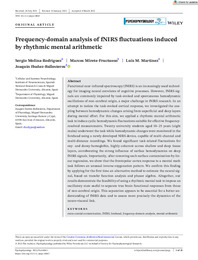Please use this identifier to cite or link to this item:
https://hdl.handle.net/11000/30624
Frequency-domain analysis of fNIRS fluctuations induced by rhythmic mental arithmetic
Title:
Frequency-domain analysis of fNIRS fluctuations induced by rhythmic mental arithmetic |
Authors:
Molina Rodríguez, Sergio
Marcos Mirete, Fructuoso
Martínez Otero, Luis Miguel
Ibáñez Ballesteros, Joaquín |
Editor:
WILEY |
Department:
Instituto de Neurociencias
Departamentos de la UMH::Fisiología |
Issue Date:
2021-07 |
URI:
https://hdl.handle.net/11000/30624 |
Abstract:
Functional near-infrared
spectroscopy (fNIRS) is an increasingly used technology
for imaging neural correlates of cognitive processes. However, fNIRS signals
are commonly impaired by task-evoked
and spontaneous hemodynamic
oscillations of non-cerebral
origin, a major challenge in fNIRS research. In an
attempt to isolate the task-evoked
cortical response, we investigated the coupling
between hemodynamic changes arising from superficial and deep layers
during mental effort. For this aim, we applied a rhythmic mental arithmetic
task to induce cyclic hemodynamic fluctuations suitable for effective frequency-resolved
measurements. Twenty university students aged 18–25
years (eight
males) underwent the task while hemodynamic changes were monitored in the
forehead using a newly developed NIRS device, capable of multi-channel
and
multi-distance
recordings. We found significant task-related
fluctuations for
oxy-and
deoxy-hemoglobin,
highly coherent across shallow and deep tissue
layers, corroborating the strong influence of surface hemodynamics on deep
fNIRS signals. Importantly, after removing such surface contamination by linear
regression, we show that the frontopolar cortex response to a mental math
task follows an unusual inverse oxygenation pattern. We confirm this finding
by applying for the first time an alternative method to estimate the neural signal,
based on transfer function analysis and phasor algebra. Altogether, our
results demonstrate the feasibility of using a rhythmic mental task to impose an
oscillatory state useful to separate true brain functional responses from those
of non-cerebral
origin. This separation appears to be essential for a better understanding
of fNIRS data and to assess more precisely the dynamics of the
neuro-visceral
link.
|
Keywords/Subjects:
extra-cranial contamination
fNIRS
forehead
frequency-domain analysis
mental arithmetic |
Knowledge area:
CDU: Ciencias aplicadas: Medicina |
Type of document:
application/pdf |
Access rights:
info:eu-repo/semantics/openAccess |
DOI:
https://doi.org/10.1111/psyp.14063 |
Appears in Collections:
Artículos Fisiología
|
 ???jsp.display-item.text9???
???jsp.display-item.text9???

.png)
